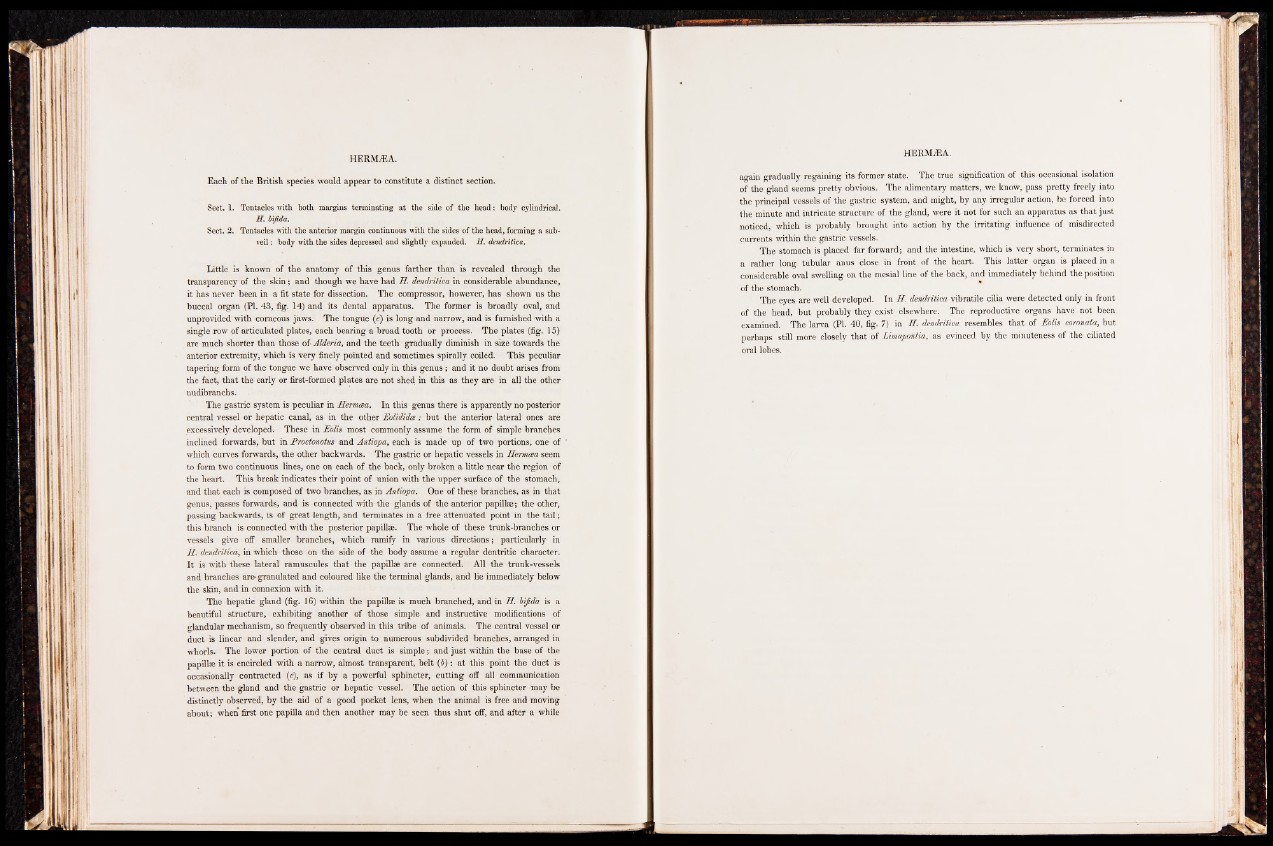
HERMiEA.
Each of the British species would appear to constitute a distinct section.
Sect. 1. Tentacles with both margins terminating at the side of the head: body cylindrical.
H. bifida.
Sect. 2. Tentacles with the anterior margin continuous with the sides of the head, forming a subveil
: body with the sides depressed and slightly expanded. H. dendritica.
Little is known of the anatomy of this genus farther than is revealed through the
transparency of the skin; and though we have had H. dendritica in considerable abundance,
it has never been in a fit state for dissection. The compressor, however, has shown us the
buccal organ (PI. 43, fig. 14) and its dental apparatus. The former is broadly oval, and
unprovided with corneous jaws. The tongue {e) is long and narrow, and is furnished -with a
single row of articulated plates, each bearing a broad tooth or process. The plates (fig. 15)
are much shorter than those of- Alderia, and the teeth gradually diminish in size towards the
anterior extremity, which is very finely pointed and sometimes spirally coiled. This peculiar
tapering form of the tongue we have observed only in this genus; and it no doubt arises from
the fact, that the early or first-formed plates are not shed in this as they are in all the other
nudibranchs.
The gastric system is peculiar in Hermcea. In this genus there is apparently no posterior
central vessel or hepatic canal, as in the other Eolidida; but the anterior lateral ones are
excessively developed. These in JEolis most commonly assume the form of simple branches
inclined forwards, but in Proctonotus and Antiopa, each is made up of two portions, one of
which curves forwards, the other backwards. The gastric or hepatic vessels in Hermcea seem
to form two continuous lines, one on each of the back, only broken a little near the region of
the heart. This break indicates their point of union with the upper surface of the stomach,
and that each is composed of two branches, as in Antiopa. One of these branches, as in that
genus, passes forwards, and is connected with the glands of the anterior papillae; the other,
passing backwards, is of great length, and terminates in a free attenuated point in the tail;
this branch is connected with the posterior papillae. The whole of these trunk-branches or
vessels give off smaller branches, which ramify in various directions; particularly in
H. dendritica, in which those on the side of the body assume a regular dentritic character.
It is with these lateral ramuscules that the papillae are connected. All the trunk-vessels
and branches are» granulated and coloured like the terminal glands, and lie immediately below
the skin, and in connexion with it.
The hepatic gland (fig. 16) within the papillae is much branched, and in H. bifida is a
beautiful structure, exhibiting another of those simple and instructive modifications of
glandular mechanism, so frequently observed in this tribe of animals. The central vessel or
duct is linear and slender, and gives origin to numerous subdivided branches, arranged in
whorls. The lower portion of the central duct is simple; and just within the base of the
papillae it is encircled with a narrow, almost transparent, belt (b): at this point the duct is
occasionally contracted (e), as if by a powerful sphincter, cutting off all communication
between the gland and the gastric or hepatic vessel. The action of this sphincter may be
distinctly observed, by the aid of a good pocket lens, when the animal is free and moving
about; when first one papilla and then another may be seen thus shut off, and after a while
HERMjEA.
again gradually regaining its former state. The true signification of this occasional isolation
of the gland seems pretty obvious. The alimentary matters, we know, pass pretty freely into
the principal vessels of the gastric system, and might, by any irregular action, be forced into
the minute and intricate structure of the gland, were it not for such an apparatus as that just
noticed, which is probably brought into action by the irritating influence of misdirected
currents within the gastric vessels.
The stomach is placed far forward; and the intestine, which is very short, terminates in
a rather long tubular anus close in front of the heart. This latter organ is placed in a
considerable oval swelling on the mesial line of the back, and immediately behind the position
of the stomach.
The eyes are well developed. In H. dendritica vibratile cilia were detected only in front
of the head, but probably they exist elsewhere. The reproductive organs have not been
examined. The larva (PI. 40, fig. 7) in H. dendritica resembles that of JEolis coronata, but
perhaps still more closely that of Limapontia, as evinced by the minuteness of the ciliated
oral lobes.